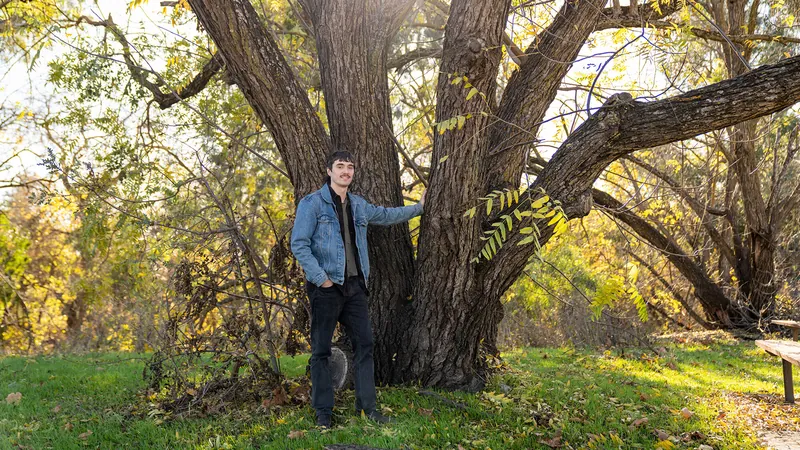
Unraveling the Secrets of Walnut Trees: How Their Gender-Bending Mechanism Mirrors Human Sex Determination
2025-01-02
Author: Michael
Introduction
In a groundbreaking study published in Science, biologists at the University of California, Davis have uncovered the genetic intricacies behind the remarkable phenomenon of alternating sexes in walnut trees. This fascinating research not only sheds light on the evolutionary adaptability of these trees but also reveals intriguing parallels to sex determination in humans and other animals, suggesting a shared biological heritage that stretches back millions of years.
The Uniqueness of Walnut Trees
Flowering plants have evolved diverse strategies to prevent self-pollination—a crucial aspect for genetic diversity. While some plants possess structural features that deter self-pollination and others have distinct male and female plants, walnut trees take this biological ingenuity to even greater heights. These trees exhibit a unique capability to produce flowers of alternating sexes within the same growing season, with individual trees consistently exhibiting either a "male-first" or "female-first" flowering pattern. This phenomenon, first observed by Charles Darwin in 1877, has puzzled scientists for generations.
Research Findings
According to Jeff Groh, a graduate student in population biology and lead author of the study, "Walnuts and pecans exhibit a temporal dimorphism, where they alternate male and female flowering during the season." While the concept has been known for over a century, the molecular mechanics behind it have only now been clarified.
The researchers conducted an extensive analysis of both cultivated walnuts and their wild counterparts, including the Northern California black walnut. They meticulously assigned these trees into male-first or female-first categories based on their flowering patterns, sequencing their genomes to identify the genetic sequences responsible for this intriguing trait.
Genetic Discoveries
In their findings, Groh and his advisor, Professor Graham Coop, discovered two genetic variants linked to the timing of flowering—one associated with female-first flowering and the other with male-first. Remarkably, this DNA variation has remained consistent across at least nine walnut species for nearly 40 million years. Groh noted, "It's quite unusual to maintain such genetic variation over such an extensive timeline." The balance of male and female flower types fosters a genetic equilibrium, ensuring that both types coexist in a near 50:50 ratio.
Comparisons with Pecan Trees
The researchers also uncovered that pecan trees, despite being closely related, harbor this flowering trait in a different genetic locus. Interestingly, the origin of the pecan variant predates that of the walnut by over 10 million years. This raises the question: How did walnuts and pecans converge on a similar flowering mechanism yet utilize distinct genetic pathways?
One possibility is that these trees’ common ancestors developed similar adaptations independently as they evolved. Alternatively, a more primitive flowering mechanism might have existed in their lineage approximately 70 million years ago, with subsequent modifications leading to the distinct genes observed today.
Parallels to Animal Sex Determination
Perhaps the most striking revelation of this research is its similarity to the sex determination mechanism found in animals, such as humans. Just as the X and Y chromosomes in mammals maintain a delicate balance, so too do the genetic variants in walnut trees.
Conclusion and Future Implications
As climate change and habitat loss increasingly threaten biodiversity, understanding the genetic underpinnings of such adaptable traits might be crucial for conservation efforts. The revelations about walnut trees not only illuminate the past but may also provide insights into the future of plant breeding and adaptation.
Now, as we embark on a journey to understand the complex relationships between plants and animals, one thing becomes clear: nature never ceases to amaze us with its ingenuity and resilience!









 Brasil (PT)
Brasil (PT)
 Canada (EN)
Canada (EN)
 Chile (ES)
Chile (ES)
 Česko (CS)
Česko (CS)
 대한민국 (KO)
대한민국 (KO)
 España (ES)
España (ES)
 France (FR)
France (FR)
 Hong Kong (EN)
Hong Kong (EN)
 Italia (IT)
Italia (IT)
 日本 (JA)
日本 (JA)
 Magyarország (HU)
Magyarország (HU)
 Norge (NO)
Norge (NO)
 Polska (PL)
Polska (PL)
 Schweiz (DE)
Schweiz (DE)
 Singapore (EN)
Singapore (EN)
 Sverige (SV)
Sverige (SV)
 Suomi (FI)
Suomi (FI)
 Türkiye (TR)
Türkiye (TR)
 الإمارات العربية المتحدة (AR)
الإمارات العربية المتحدة (AR)